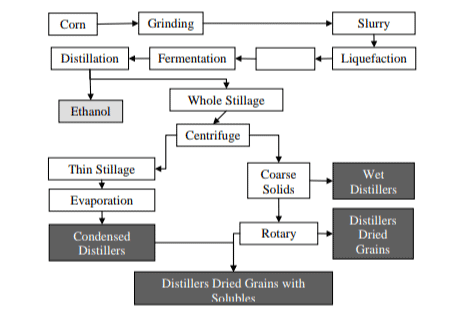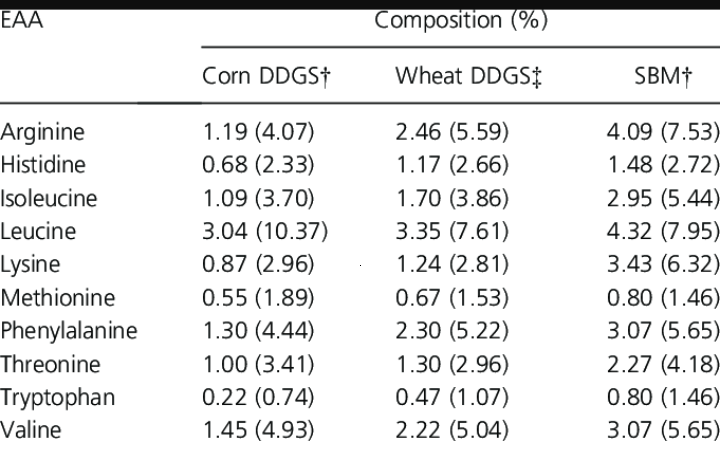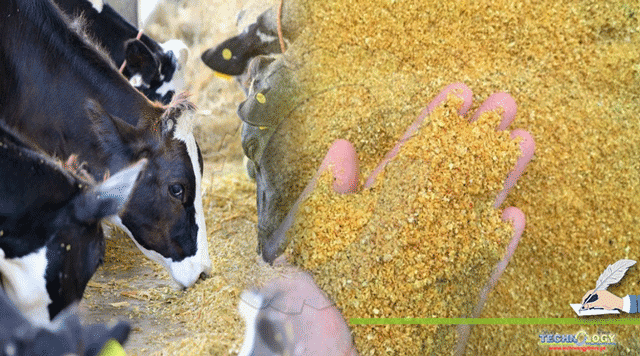Distiller’s dried grains with soluble (DDGS), a dried residue that remains after the fermentation of grain mash by selected yeasts and enzymes to produce ethanol and carbon dioxide, is currently readily available and less expensive than other conventional protein sources on a per unit protein basis.

By Dr. Muhammad Ali Tahir, Dr. Muhammad Akram, Dr. Ali Hussain and Dr. Muhammad Amer Sohail
Introduction to Distiller dried grains (DDGS)
The data was gathered after searching for relevant articles published in the World Health Organization’s (WHO) website, Centers for Disease Control and Prevention’s (CDC) website, and some other related websites on the Internet.


Dry grind ethanol production process
The Distilled Dried Grain soluble is produced by using Dry -grind technology. In which corn size is reduced by grinding in a hammer mill at high speed. We kept the size of the screen 3 to 5mm diameter to increase ethanol production as compares to screen size 8mm because the size of the particle directly affects the production of ethanol yields. This table shows the whole process of Distilled Dried Grain soluble production from corn ingredients.

Physical characteristics of DDGS
Corn DDGS is a free-flowing granular product with a color ranging from light yellow-tan to dark brown. The color of wheat DDGS varies from light to dark brown. In general, corn and wheat DDGS are deficient in lysine and methionine. This lysine and methionine deficiency can be overcome by their supplementation in diets with a DDGS inclusion rate of 40℅. The dark-colored corn DDGS has a lower nutritional value. The dark brown color is a result of overheating during the drying process leading to binding and or destruction of nutrients such as lysine. Distiller’s dried grains with soluble also contain yeast, a rich source of beta-glucan and nucleotides that have been reported to enhance immunity and disease resistance in Animal Corn DDGS, owing to its high oil content, is rich in linoleic acid and is an excellent source of energy and essential fatty acids for animals. High concentrations of xanthophylls present in corn DDGS.
Proximate composition
The proximate composition of representative corn and wheat DDGS is presented in Table 1. Distiller’s dried grains with soluble have very low concentrations of starch because most of the starch in the grain is converted to ethanol during the fermentation process. Wheat DDGS have higher crude protein, but lower crude fat content than corn DDGS. Corn DDGS generally have a higher crude fiber content (10.9–12.6%) than wheat DDGS.
Essential amino acids
The essential amino acid (EAA) composition of corn and wheat DDGS and dehulled solvent-extracted soybean meal (SBM) is presented in Table 2. DDGS from corn and wheat are deficient in several EAA, including lysine, threonine, tryptophan, arginine, isoleucine, and phenylalanine, relative to SBM. Moreover, corn DDGS is also marginally deficient in tryptophan.

Vitamin and Minerals
Similar to other nutrients, the vitamin and mineral concentrations vary greatly among sources of and batches of DDGS. Corn DDGS is a rich source of vitamin A, niacin, choline, and several trace minerals and also contains a high level of highly available phosphorus.
The influence of DDGS at a different level on Milk production
Daily milk production of cows fed different levels of DDGS was presented in Figure 1. All cows’ milk production was in the declining phase as they were in the later stage of milk production. Figure 1 shows clearly that milk production from cows fed control diet declined at a much faster rate than that cows fed DDGS 7.5% and the least decline was found in cows fed DDGS 15%.

Many research studies on extensive trials on DDGS indicated that milk composition was not affected by feeding DDGS at 4-30%. Feeding DDGS did not affect fat content in milk despite DDGS contains a reasonable amount of fat (>9%). Milk protein percentage was not different among cows fed diets containing 0-30% DDGS, and the form of the DDGS either wet or dried form did not alter milk protein composition.
Daily milk production can be increased up to 2 – 4 kg by feeding DDGS of corn and wheat at an inclusion level of 7.5 &15℅. Other possible factors that influence DDGS on milk production may relate to a less digestive disturbance found when DDGS was included in the diet during a prolonged period, higher rumen undegradable protein (RUP) in DDGS diet may also contribute to higher milk production.
The negative result of DDGS in higher inclusion rate in diets
However, milk protein percentage decreased by 0.13% when distiller’s grains were included at concentrations greater than 30% of the diet compared to cows fed the control diet. At the higher dietary inclusion levels, distiller’s grains most likely replaced all other sources of protein in the diet. At these high levels of dietary inclusion, lower intestinal protein digestibility, lower lysine concentrations, and an unbalanced amino acid profile may all contribute to a lower milk protein percentage. It should be noted that the lower milk protein percentages were most evident in studies conducted in the 1980s and 1990s.
Modifications in ethanol production in plants
In the last few years, ethanol production continued to change and at the present majority of ethanol plants have installed centrifuge to remove oil during the production and this method resulted in lower oil content of DDGS. Previously DDGS contains 10-12%fat but there are many DDGS contain 5-7% oil but may contain higher protein. Limited studies have been conducted on reduced oil DDGS for dairy cows but reduced oil content of DDGS may be desirable for dairy cows as many nutritionists believe that high oil of DDGS may limit the inclusion rate besides high unsaturated fatty acids found in DDGS oil. More studies would be required to look at the impact of low oil DDGS on dairy cows.
Conclusion
A diet containing DDGS is readily consumed by dairy cows. Feeding DDGS was able to improve the milk yield of cows raised under hot and humid conditions. Their amino acid deficiency like lysine, methionine, tryptophan, and others are fulfilled by supplementation of these amino acids in diet formulation with an increase in DDGS rate maximum of 40℅. Diet containing 15% DDGS was able to maintain the daily milk production and resulted in 4 kg higher compared to the control diet, while diet containing 7.5% DDGS resulted in 2 kg higher. Milk quality from a cow fed 15% DDGS tended to be better compared to that cow fed 7.5% DDGS and control diet.
Author: Dr. Muhammad Ali Tahir, Dr. Muhammad Akram, Dr. Ali Hussain and Dr. Muhammad Amer Sohail
